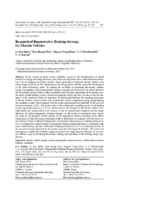| dc.contributor.author | Le, Van Nghia | |
| dc.contributor.author | Dam, Hoang Phuc | |
| dc.contributor.author | Nguyen, Trong Hoan | |
| dc.contributor.author | Kharitonchik, S. V. | |
| dc.contributor.author | Kusyak, V. A. | |
| dc.coverage.spatial | Минск | ru |
| dc.date.accessioned | 2023-04-22T10:21:54Z | |
| dc.date.available | 2023-04-22T10:21:54Z | |
| dc.date.issued | 2023 | |
| dc.identifier.citation | Research of Regenerative Braking Strategy for Electric Vehicles = Исследование стратегии рекуперативного торможения электромобилей / Van Nghia Le [et al.] // Известия высших учебных заведений и энергетических объединений СНГ. Энергетика. – 2023. – № 2. – С. 105-123. | ru |
| dc.identifier.uri | https://rep.bntu.by/handle/data/127392 | |
| dc.description.abstract | In the context of global energy instability caused by the transformation of global demand for energy and energy resources, one of the most important areas in the automotive industry is the development of electric vehicles. Serial production of high-tech electric vehicles with a long range contributes to the stabilization of the energy market and the sustainable development of the whole fuel-energy sector. To evaluate the possibility of optimizing the electric vehicles energy consumption, various regenerative braking strategies are discussed in the article based on the Nissan Leaf electric vehicle, which simulation model includes submodules of the traction electric motor, hybrid braking system, traction rechargeable battery and tires. In order to test the adequacy of the simulation model to reproduce the relationship between the operating parameters of electric vehicles various systems and evaluate their ability to regenerate energy during braking the simulation results were compared with the actual experimental data published by the Lab Avt research laboratory (USA). The relative error of the mathematical modeling results of the braking energy regeneration processes is 4.5 %, which indicates the adequacy of the electric vehicle simulation model and the possibility of its using as a base for research and comparison of the energy efficiency of various regenerative braking strategies. As the results of experiments have shown, the usage of the proposed control strategy of the regenerative braking maximum force allows increasing 2.14 times the energy recharging traffic to the battery as compared with the basic control strategy of fixed coefficient braking forces distribution with an increase in braking distance by 10 m. An alternative control strategy of regenerative braking optimal efficiency as compared to the basic control strategy provides a reduction in braking distance by 13.2 % at increasing by 84.4 % the amount of energy generated by the electric motor for recharging the batteries. The carried out investigations confirm the available significant potential for improving the efficiency of the electric vehicles usage by developing the control strategy and algorithms of the braking energy regeneration. | ru |
| dc.language.iso | en | ru |
| dc.publisher | БНТУ | ru |
| dc.title | Research of Regenerative Braking Strategy for Electric Vehicles | ru |
| dc.title.alternative | Исследование стратегии рекуперативного торможения электромобилей | ru |
| dc.type | Article | ru |
| dc.identifier.doi | 10.21122/1029-7448-2023-66-2-105-123 | |
| local.description.annotation | В условиях энергетической нестабильности, вызванной трансформацией глобального спроса на энергию и энергоресурсы, одним из важнейших направлений в автомобилестроении является разработка транспортных средств на электрической тяге. Серийное производство высокотехнологичных электромобилей с большим запасом хода способствует стабилизации рынка энергоресурсов и устойчивому развитию всего топливно-энергетического сектора. Для оценки возможности оптимизации энергопотребления электромобилей в статье рассматриваются различные стратегии рекуперативного торможения на базе имитационной модели электромобиля Nissan Leaf, включающей субмодули тягового электродвигателя, гибридной тормозной системы, тяговой аккумуляторной батареи и шин. Результаты моделирования сопоставлялись с экспериментальными данными научно-исследовательской лаборатории Lab Avt (США), опубликованными для проверки адекватности имитационных моделей, воспроизводящих взаимосвязь между рабочими параметрами различных систем электромобиля и оценивающих их способность регенерировать энергию при торможении. Относительная погрешность результатов математического моделирования процессов рекуперации энергии составляет 4,5 %, что свидетельствует об адекватности имитационной модели электромобиля и возможности ее использования в качестве базовой для исследований и сопоставления энергоэффективности различных стратегий рекуперативного торможения. Как показали результаты экспериментов, использование предлагаемой стратегии управления максимальной силой рекуперативного торможения позволяет увеличить трафик энергии подзарядки в 2,14 раза по сравнению с базовой стратегией управления на основе фиксированного коэффициента распределения тормозных усилий по осям транспортного средства при увеличении тормозного пути на 10 м. Альтернативная стратегия управления оптимальной эффективностью рекуперативного торможения обеспечивает по сравнению с базовой стратегией уменьшение тормозного пути на 13,2 % при одновременном увеличении на 84,4 % количества вырабатываемой электродвигателем энергии для подзарядки тяговых аккумуляторных батарей. Проведенные исследования подтверждают имеющийся потенциал по повышению эффективности использования электромобилей за счет совершенствования стратегии и алгоритмов управления рекуперацией энергии торможения. | ru |

